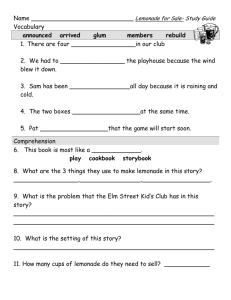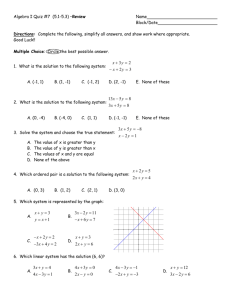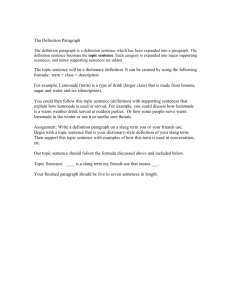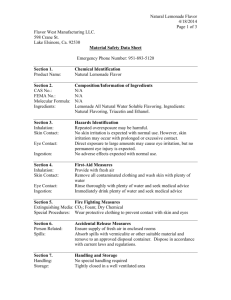Supply and Demand
advertisement
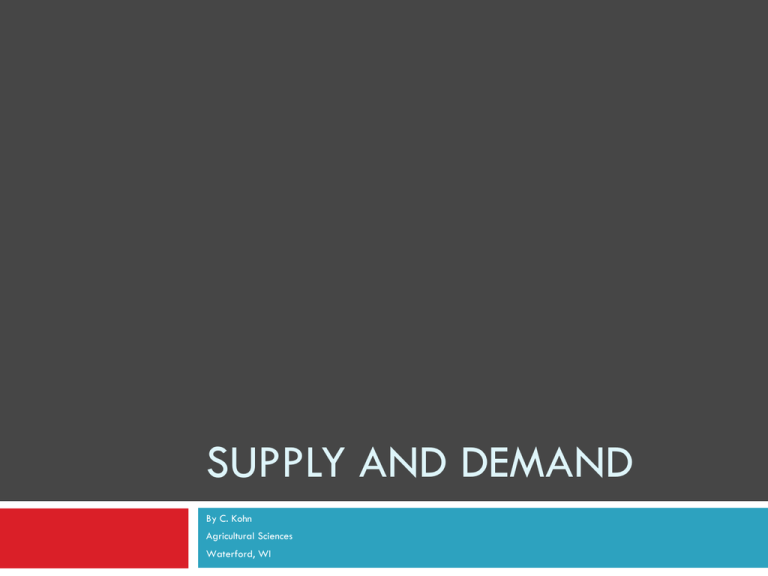
SUPPLY AND DEMAND By C. Kohn Agricultural Sciences Waterford, WI Supply and Demand The most basic laws of economics are supply and demand. Law of supply: as the quantity of a good offered for sale rises as its price rises. Basically everything in economics is ultimately because of the interaction of the supply of goods and services and the subsequent demand for those same goods/services. Because a seller can make more money, their desire to sell a good increases as its price increases. Vice versa, the quantity of a good offered for sale will decrease as its price falls. Law of demand: the demand for a good will decrease as its price rises, and the demand for a good will increase as the price falls As something becomes cheaper, you can acquire more of it for the same amount of money, increasing your desire to purchase that product. Markets and Supply/Demand Markets enable levels of supply and levels of demand to find an equilibrium point. The equilibrium point is the balance between the demand for a product and the amount supplied for sale. The point where the levels of supply and demand are equal determines the price offered for a good. The best cure for prices that are too low are prices that are too low. If the price of a good is too low, then producers stop selling that product. The reduction in producers results in a reduction in the supply; a reduction in the supply will eventually cause the price to rise as consumers will offer to pay more as the product becomes more rare. The best cure for prices that are too high are prices that are too high. If the price for a good is too high, then consumers will slow their purchase of that good. A reduction in the number of consumers who are willing to buy means that producers will reduce the price of their good (e.g. a store might have a sale). This reduction in price will encourage more consumers to purchase the good again. Supply and Demand Curves Typically, supply and demand are shown using graphs. These lines are called curves. A supply curve shows all of the prices that various sellers would be willing to sell their product at. A demand curve shows all the prices at which various sellers would be willing to purchase that product. Willingess to Sell at Different Prices Image a hypothetical town square. Along each side of the town’s square are little girls with lemonade stands (four total). At lemonade stand #1, a girl is willing to sell her lemonade for 25 cents. At stand 2 and 3, the girls would sell for 50 cents. At stand 4, the girl will not sell for anything less than $1. $1.20 $1.00 Price of Lemonade What should be the price they sell at? $0.80 $0.60 $0.40 $0.20 $0.00 0 1 2 3 # of girls willing to sell lemonade 4 5 Lemonade Girls Our lemonade stand girls need to know their potential customers’ willingness to buy lemonade and their own supply of lemonade in order to determine their price. Imagine there are four customers. They would all prefer to buy lemonade at 25 cents. However, if only lemonade stand 1 is selling it for 25 cents, the supply of lemonade would run out pretty quickly. Over time, the girl at lemonade stand #1 might also realize she isn’t making any money, reducing her willingness to sell at this price. However, most of the customers would also be willing to pay 50 cents (although a dollar is probably too steep). Willingness to Buy at Different Prices $1.20 $1.00 $0.80 Price $0.60 $0.40 $0.20 $0.00 0 1 2 3 4 No. of Customers Who Buy At Each Price 5 Lemonade Equilibrium Over time, with repeated transactions, the sellers and buyers would start to realize that 50 cents is probably the best price at which to sell lemonade. 50 cent lemonade allows each seller to make some money without severely affecting the customers’ willingness to buy that lemonade. Although the sellers would prefer to sell their lemonade at higher prices, they also know that doing so would drive their customers to one of the other three stands. The buyers would prefer to buy at lower prices but know that sellers wouldn’t be willing offer them a lower price. Lemonade Curves Our lemonade stand example can be easily summed by showing the supply and demand curves. Our sellers (or producers) wanted to sell at 25 cents, 50 cents, and one dollar. Our customers (or consumers) wanted to buy at various prices; while they would prefer it to be 25 cents (or lower), they would be willing to pay up to a dollar. However, as the price rises, so few customers would be willing to buy lemonade that it wouldn’t make sense to bother selling it at all. We can see that the largest number of customers and the largest number of sellers together would be willing to buy/sell lemonade at 50 cents. Hence this is the correct price at which to sell lemonade in this example. Demand Curve Shifters Price is not the only factor that affects demand. Factors other than price that change demand are called demand curve shifters. Demand curve shifters include prices of substitute and complementary goods, income of consumers, changes to the number of customers in a market, and the perceived value of a product by the consumer. Demand curve shifters are called this because on a graph, they literally shift the demand curve left or right, changing the demand for a product at the same prices. For example, imagine that a family normally buys 10 apples each week for $10. Without warning, a family member loses a job, reducing their total income. Realizing they have to save money, that family now buys 5 apples per week. Despite the price not changing, the family’s willingness to buy at each price is now half of what it was before without any change to the product or price. Demand Shifters Demand curve shifters change the willingness of a consumer to purchase a good at any given price. For example, imagine that a great marketing campaign makes a product seem more valuable. Those customers are now more willing to purchase that good at the same price, increasing demand without decreasing the price. This can also go in reverse. For example, negative publicity might decrease the amount of a good that consumers purchase even if the price is lowered. Complementary & Substitute Goods Substitute goods and complementary goods also have a major impact on demand. A substitute good is one that could take the place of another product due to its similarity if its price is lower than the original good. Coke and Pepsi are classic substitute goods. If the price of Coke rises, the demand for Pepsi will increase without any change in the price for Pepsi. This should make sense. Why pay more for Coke when Pepsi is cheaper and similar. While not all customers will think this way, enough would potentially shift brands to prevent Coke from making this decision. Complementary goods are those items that we buy together. For example, if you buy hotdogs you usually also buy hotdog buns. If the price of hotdogs goes up, your willingness to buy hotdog buns decreases at the same price. Demand Curve Shifters Shifts in the customers’ perceived value of a product can also increase demand at the same prices. The purpose of marketing in business is to change the perceived value of a product so that a customer is more willing (usually) to purchase a product. With proper marketing techniques, a customer will be willing to acquire more of a product at the same price. It is important to remember that moving along a demand curve and move a demand curve are two different ideas. Changing the price changes the willingness of a consumer to buy a product. Changing the perceived value of a product changes the willingness of a consumer to buy a product at the same price. Increasing the price will decrease demand, resulting in lost profit. Increasing demand for a product at the same price through an increase in perceived value will result in increased profit due to an increase in consumer demand. Supply Curve Shifters Just as there are demand curve shifts, there are also supply curve shifters. Supply curve shifters change the willingness of a producer to sell a product at a given price. Supply curve shifters increase or decrease how likely a producer will sell a good at its existing price. Supply curve shifters include: Cost of inputs – as the price of inputs decrease, the willingness to sell increases. Available technology – improvements in technology increase the willingness of producers to sell. Profitability of other goods – as other similar goods become less profitable, a producer is more willing to sell their good. Number of sellers in the market – an increase in the number of sellers of a good will decrease the willingness of others to sell that good. Consumer expectations – as consumers’ expectations rise, a producer’s willingness to sell may decrease. Supply Shifters Supply curve shifters change the willingness of a supplier to provide a good at the same price. For example, imagine that a new piece of machinery makes it much easier to harvest corn. This new technology would make a supplier more willing to harvest more corn even if the price stayed the same. Supply shifters change the willingness of a supplier to sell their goods without increasing or decreasing the price offered for those goods. This too can work in reverse. For example, if wheat suddenly become much cheaper to grow, more farmers might switch to wheat from corn. Lemonade Supply Shifters Supply Curve Shifter example – the lemonade girls Let’s reconsider our example of our girls selling lemonade. The willingness of those girls to go out and set up a lemonade stand can be affected by each of the following: Cost of inputs: if the price of lemonade rises at the grocery store, the girls are less willing to purchase the lemonade concentrate in order to sell. Available technology: if the girls have to squeeze the lemons by hand instead of just using the concentrate, they will be less willing to sell lemonade. Profitability of other goods: if iced tea sells more easily than lemonade, the girls will be less likely to sell lemonade. Number of sellers in the market: if more girls start setting up lemonade stands, those girls might decide to sell something else. Consumer expectations: if the consumers start demanding fresh-squeezed lemonade instead of concentrate, those girls may start to sell something else. Exceptions to Supply/Demand Supply and demand can seem simply on the surface. As prices rise, consumers are less willing to buy and producers are more willing to sell. As prices decrease, consumers are more willing to buy and producers are less willing to sell. Increases to the perceived value of a product make a consumer more willing to purchase a product at the same price. Improvements to the production of a product make producers more willing to sell a product at the same price. However, many products do not fit this model as nicely. Elasticity of Demand One factor that has a major impact supply and demand is a concept called elasticity of demand. Elasticity of demand is a measure of how much a change in price will change a consumer’s willingness to purchase a product at a certain price. Elasticity of demand is calculated by comparing the percent change in demand compared to the percent change in price. A product that has zero change in demand with a significant change in price is called demand inelastic. A product that has an similar change in demand compared to a change in price is considered to have an elastic demand. Demand is sort of like a waistband. Jogging pants have an elastic waistband – the waistband stretches as your body moves. Dress pants have an inelastic waistband – the pants’ waist stays the same size no matter what. Elastic demand shifts as prices shift (just like jogging pants shift as your belly grows). Inelastic demand stays the same no matter what the price (just like dress pants will have the same waist no matter what size your belly is). Elasticity & Business Elasticity of demand can have a huge impact on how a consumer addresses demand curve shifters or supply curve shifters. For example, if you are an electrical company, you aren’t as concerned about rate hikes because electricity typically has an inelastic demand. However, if you sell something with an elastic demand (such as chocolate), price increases can have a huge impact. People will still use about the same amount of electricity regardless of its cost (to an extent). If the price of chocolate goes up, people may just choose to not consume it at all. Producers who sell goods with an elastic demand have to be much more concerned about changes to the price of that item than those who sell goods with an inelastic demand. However, those who sell goods with an inelastic demand will not increase the sales of their good if they lower the price (such as with a sale). Price Ceilings Sometimes governments or social policy can interfere with relationships between prices and the levels of supply and demand. For example, sometimes people or governments demand that a maximum price be established for a good or service. Rent control is an example of a price ceiling. A price ceiling prevents a price for a good from rising above an established maximum. Rent control is a government policy that prevents the price of rent from exceeding a certain maximum in order to make housing more affordable. Usually price ceilings are found below the equilibrium price for a good or service. A price ceiling, usually found below the equilibrium price, creates a mismatch in supply and demand. At the $2 price shown here, only 2 supplies would be willing to sell but four customers would be willing to purchase. In this case, demand is twice as high as supply. Price Max’s = Bad Typically a price maximum is economically a bad thing because it results in a shortage for that good. This is because levels of demand will be higher than levels of supply due to the fact that the price is not allowed to reach the equilibrium point where levels of demand equal levels of supply. Price ceilings may also result in a reduction in the quality of a good; because the demand exceeds the supply of a good, a reduction in the quality of a good does not change the demand for the good because demand already exceeds the supply. Price Ceiling The yellow line represents a price ceiling. The price that is forced is below the equilibrium price. As a result, more is demanded than is supplied. This results in a shortage of the good that is offered. Because of this, supply fails to meet demand. Price Floors Social policy may also establish a price floor, in which the price of a good is not allowed to fall below an established minimum. Some agricultural subsidies work in this way, where the government will pay farmers if market prices fall below an established minimum. Price floors are also bad economically-speaking because they result in surpluses of a good. As a result of a price floor, the supply will exceed the demand, resulting in unsold goods or services. While price floors are created to prevent economic losses to a producer, they can actually increase the losses to a producer due to the fact that their good or service may go unpurchased. Price Floors Price floors actually result in fewer goods being sold. This is because supply exceeds demand. As a result, fewer consumers will purchase that good than they would have had the price been at the equilibrium price. Even though the price is forced to be higher, the suppliers actually will make less money due to lowered demand. Agricultural Economics Agricultural subsidies are controversial topics because they don’t fit nicely into economic theories. While price floors are universally viewed as bad economic policy, the nature of agriculture changes the situation. While a factory can slow or stop production of its good if demand begins to fall, a farm cannot reasonably slow the production of milk from its cows, for example. However, unsold agricultural goods that result from the surpluses caused by a subsidy are also bad news for farmers. Furthermore, agriculture is affected more by uncontrollable and unpredictable events, particularly the weather. Finally, a steady and predictable supply of food is absolutely vital for national security and well-being. We live in a country where food shortages are relatively unknown – this is a good thing. Americans spend less of their total personal budget on food than almost any other nation in the world. MILC One successful method for supporting agricultural production and a healthy national supply of affordable food is the MILC subsidy. MILC is a partial subsidy – it only kicks in if the price of milk falls below the breakeven point. MILC is an acronym for Milk Income Loss Contract. It is a partial-subsidy program for US dairy farmers to ensure market stability for dairy products. For example, if a farmer needs to make $15 per hundred pounds of milk sold (or hundredweight) in order to break even, the MILC subsidy is only paid if the price of milk falls below $15 per hundredweight. MILC also only makes up a third of the difference between the profit point and the actual price. For example, if the price of milk falls to $12 per hundredweight, the government only provides a third of the difference between that price ($12) and the profit-point price ($15). In other words, if the price of milk falls to $12, the government adds $1 per hundredweight to raise the price to $13. MILC MILC works from an economic perspective because it still allows price to affect supply and demand. The MILC subsidy does not kick in unless it costs more to make the milk than is received when it is sold. Furthermore, the MILC subsidy doesn’t prevent the producer from losing money when the price falls too low; it only ‘softens the blow’ of these situations. MILC allows low prices to reduce the supply of milk. A reduction in the supply of milk will result in an increase for the price offered for that milk. However, it will reduce the number of farms that go bankrupt. Market forces can restore the equilibrium between supply and demand but reduce the permanent impact that factors like bankruptcy of farms has on the dairy industry.

